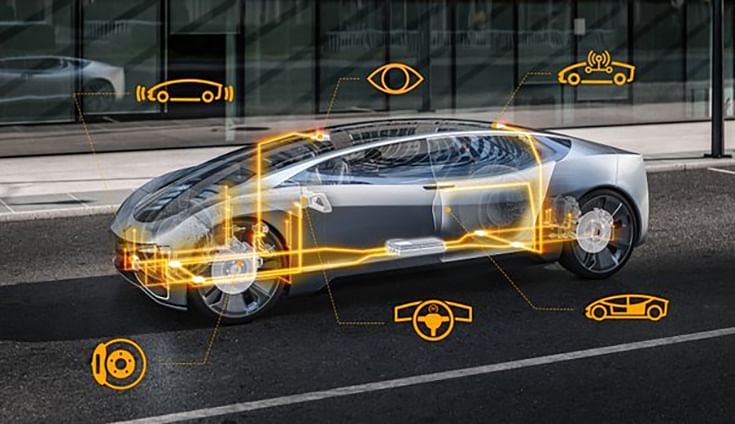Connectivity and SDVs to drive up to 30% OEM revenues from services by 2030
As the megatrend of Software Defined Vehicles takes firmer shape, OEMs are increasingly switching from selling vehicles to marketing features and regularly updating them to enhance the user experience.
As vehicles increasingly transform into computers on wheels with the growing implementation of connected infotainment units as well as telematics-based connected-car technologies that allow remote control of certain vehicle features, the business model in the automobile industry is fast changing from that of selling cars to marketing features and services.
OEMs are now moving towards exploring new revenue streams even once a vehicle is sold, and this shift in business model is what is the key driving force behind what are now being termed as software-defined vehicles (SDVs).
According to Kishor Patil, co-founder, MD, and CEO, KPIT, “OEMs are switching away from selling cars to selling features and services. They want to keep updating the car on a regular basis to maintain the customer connect beyond the point of sale.”
“That is why they want to remain connected and this is the change in the business model. A couple of OEMs (carmakers) started selling features, and the trend is now being followed across the industry. The whole concept of an SDV and the new centralised architecture provides an opportunity to the OEMs to change their business model,” he added.
Patil, who was one of the panellists at the National Association of Software and Service Companies (NASSCOM) roundtable moderated by Autocar Professional on the side lines of the NASSCOM Design and Engineering Summit 2022 in Bengaluru recently, explained that until the time OEMs decided to pivot, connectivity was restricted within the confines of the vehicle.
“However, cars are now getting connected with other vehicles on the roads, as well as with the infrastructure, and this allows OEMs to update the features remotely while also providing various other services like personalisation. This has brought connectivity at the focal point,” Patil said.
According to Debashis Neogi, managing director, Renault Nissan Technology & Business Centre India, “Up to 30% of OEM revenues are likely to come from services in the coming future. While mature markets such as the US and Europe are eyeing this by 2030, it would take a little longer for India as we need to brace our connectivity infrastructure and vehicle e-architectures. However, we will not be much far behind.”
Connectivity and the sustainability connect
Neogi said that data is enabling OEMs get closer to their customers and understand them better, and that connectivity is also critical from an ESG perspective as it allows carmakers to solve traffic woes, and in turn reducing CO2 emissions. He further pointed out that product development is getting efficient, fast, and competitive with digital twins and that the concept is dynamically cutting across the entire automotive landscape.
 Latha Chembrakalam, vice-president and head of Technical Centre India, Continental, concurred with Neogi’s comments and said, “Hyperconnectivity is a key aspect of the automotive value chain in the present day. Connectivity is generating more data related to convenience and vehicle safety.”
Latha Chembrakalam, vice-president and head of Technical Centre India, Continental, concurred with Neogi’s comments and said, “Hyperconnectivity is a key aspect of the automotive value chain in the present day. Connectivity is generating more data related to convenience and vehicle safety.”
She added that the automotive industry is eyeing expansion of its horizon with vehicle connectivity and Mobility-as-a-Service or MaaS is now giving birth to Lifestyle-as-a-Service concept with more opportunities for both OEMs and suppliers.
“IoT, Big Data, and AI are bound to play an important role in the transformation of the sector which is increasingly looking at digital retail and last-mile delivery. The contextual data requirements of OEMs are being solved by connectivity,” Chembrakalam added.
KS Viswanathan, vice president, Industry Initiatives, NASSCOM, said, “We expect around 60-70 percent of the automobiles to be software defined by 2025-26, and this is going to be completely augmentative and faster than what we are witnessing today.”
“India is home to a million people working in the engineering-R&D ecosystem. Of this, approximately 600,000 people are working in the software, embedded systems and electronics domain, and the demand for this skillset is growing at a rate of 33 percent every year. Globally, the automotive industry is projected to demand 150,000 software engineers in the coming future and India offers huge potential to supply qualitative software engineers in scale,” Viswanathan signed off.
SEE THIS VIDEO:
Autocar Professional-NASSCOM Roundtable | Revolutionising Mobility: The Future of a Hyperconnected World
RELATED ARTICLES
Next-Gen Tata Harrier and Safari Likely to Feature All-Wheel Drive System
The second-gen Harrier and new-gen Safari are codenamed Taurus and Leo, respectively.
Exclusive - Tata Motors Plots Comeback with New Nexon, Sierra, Avinya Brand and Compact Lifestyle SUV in Rs 35,000 Cr Overhaul
Tata targets ₹10–20 lakh sweet spot and premium electric space with multi-platform offensive across ICE, EV, and hybrid ...
Exclusive: Tata Motors Partners Desay SV to Accelerate Software-Defined Vehicle Strategy
Desay SV to support Tata Motors in building SDV platform for EVs and ICE vehicles across segments.





 15 Dec 2022
15 Dec 2022
 9178 Views
9178 Views
















 Autocar India
Autocar India




